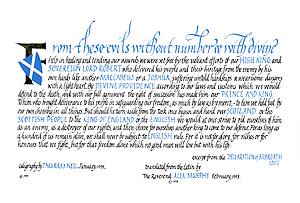
THE DECLARATION OF ARBROATH (Calligraphy Print)

Calligraphy print of Excerpt from
the Declaration of Arbroath.
Size 370mm x 256mm without mount(mat)
Description
This unique calligraphy print is an excerpt from a new translation into English from the Medieval Latin of the Declaration of Arbroath by the Reverend Alex C. Murphy. It is written in italic using blue and black inks with a metallic gold illuminated capital against which leans a shield bearing the cross of St Andrew.Excerpt from The Declaration of Arbroath
From these evils without number and with divine help in healing and tending our wounds, we were set free by the valiant efforts of our High King and sovereign Lord Robert, who delivered his people and their heritage from the enemy by his own hands like another Maccabeus or a Joshua, suffering untold hardships and wearisome dangers with a light heart. To him who has brought deliverance to his people by safeguarding our freedom, as much through justice as by merit, - to him we hold fast by our own choosing in all things. But should he turn aside from the task once begun and hand over Scotland or the Scottish people to the King of England or the English, we would at once strive to rid ourselves of him as an enemy, as a destroyer of our rights, and then choose for ourselves another king to come to our defence. For as long as a hundred of us remain alive, we shall never be subject to English rule. For it is not for glory, for riches or for honours that we fight, but for that freedom alone which no good man will lose but with his life.Historical Note
This letter to Pope John XII was probably written by Bernard de Lion, Chancellor of Scotland and Abbott of Arbroath, and seems to have been planned at Newbatttle, near Dalkeith in March 1320. After the battle of Bannockburn in 1314 Robert I (Robert Bruce) was effectively King; he was supported by all Scots who could now show a united front to the rest of Europe and appear as a nation independent of England, but, King Edward II of England was still determined to bring the Scots under his kingship, urging Pope John XII to support him. The pope repeatedly sent Bulls of excommunication to Robert in the years leading up to the Declaration of Arbroath.The declaration is about Scottish nationhood, the unity of the people and the kingship of of Robert I. This letter served a s a powerful appeal to the Pope to urge King Edward to leave the Scots in peace, and to respect their deepest desires to be independent. The Pope did in fact respond to the letter and urged King Edward to lean less heavily on the Scots. But skirmishes with England continued until 1327 when Edward II was deposed. Finally on the first of March 1328 Edward III officially renounced all claims to Scotland and acknowledged Robert I as King of Scots. Because of its noble sentiments parts of the Declaration were later incorporated into the American Declaration of Independence.
ORDERING INFORMATION
The print is 370mm x 256mm and is supplied without mount(mat).
Price including p&p £20; £24 (Outside UK)
Click Here for Currency Converter
BUY NOW
Please use the Paypal link below to buy online.